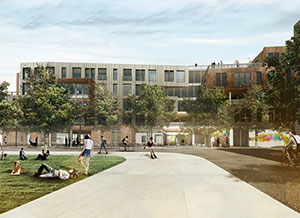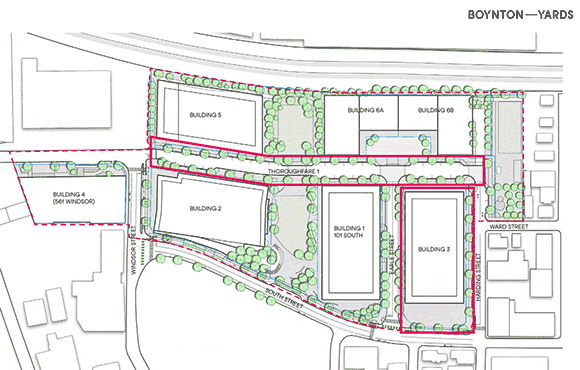
A new street design for Thoroughfare 1, part of the Boynton Yard Master plan, was recently presented to city officials and the public.
By Ryan DiLello
On Wednesday, April 6, the Boynton Yards development team presented a new street design for Thoroughfare 1, within the 6.8-acre Boynton Yard Master plan. About three dozen city organizers, City Council members, and residents attended to see the updated plans and to ask questions and leave comments, following a presentation from the development team.
Ian Ramey, principal at Copley Wolff Design Group, led the 25-minute presentation, beginning with a project timeline.
In the fall, the development team will start on a more detailed design, he said, collaborating with city departments. In early spring of 2023, the group hopes to begin construction in two phases; first at the western edge of the thoroughfare, between Windsor Street and Earl Street, followed by the eastern portion between Earl and Harding Street. They plan to finish construction by the end of 2024.
“This is a privately funded thoroughfare that will be transferred over to the city as a public street,” Ramey said. “[We] want to prioritize people, public realm activation, and green infrastructure over vehicles,” he said, noting that this was a concept which the city of Somerville brought to developers. “Traffic will be slowed, vehicular access through the corridor will be discouraged,” Ramey continued.
With the timeline set, Ramey delved into goals centered around pedestrians, vehicles, and green infrastructure.
Pedestrians and Vehicles:
A primary goal is ensuring that the thoroughfare will provide a safe and lively “civic space, optimized for everyday use.” Developers took a key step here in designing the street to deter vehicles with limited parking spaces and non-traditional road materials. They also engineered ways to attract pedestrians by making the streets adaptable to multiple purposes like festivals.
Developers have decreased the allotted parking spaces from 30 to 18, including two van-accessible parking spaces. Ramey noted that some of these spaces are apt for bike lockups.
Green Infrastructure:
Ramey mentioned that early plans for the thoroughfare “felt still more like a traditional street that happened to have a good amount of tree canopy.” Today’s plans use the trees as ways to break up the street, “taking larger clusters of trees, interjecting them into the street space,” Ramey said, which he clarified, is an effort to “blur the lie between the pedestrian sidewalk and the road.
Biodiversity has been a central concern within green infrastructure planning. Ramey said the development team is committed to at least 50% native species and plans to maximize the tree canopy. Other important factors include ease of maintenance, health and viability (especially given stormwater runoff and harsh conditions associated with a high-traffic area), as well as maximizing ecological value.
The development team also considered auxiliary infrastructure like tree guards, irrigation paths along sidewalks and through curbs, and mini basins, to ensure water reaches the trees sustainably.
With the goals established, Ramey gave a brief overview of next steps.
“As we move through this process, we will meet with the city department, refine design concepts, and present to the UDC,” Ramey said. Rola Idris, Project Manager from Leggatt McCall Properties clarified that a community meeting will occur after the team presents its plans to the UDC.
“As that process unfolds [with the UDC], we’ll be preparing our official SPA documents to submit to the city. And then by the spring, hopefully we’ll have planning board hearings and design development beyond that,” Ramey concluded, opening the floor for questions and comments.

A representation of Thoroughfare 1’s placement within the Boynton Yard Master plan.
Q+A Section:
Questions covered biodiversity, green infrastructure, plans for retail spaces, and traffic changes during and after construction.
The first question came from a local resident, who asked whether developers would consider sharing the abundance of trees, where they may be excess, with neighborhoods in Somerville in need of more trees. “Trees for everyone,” Ward 2 City Councilor J.T. Scott said. “I think that’s a fair question,” he said, but neglected to answer it.
The same resident also asked about crosswalk maintenance, noting that deteriorated crosswalks posed a danger for pedestrians, as well as vehicle speeding issues arising from construction workers leaving their worksites. “I can understand wanting to get out of work early, but also taking your time in our neighborhood.”
Kevin Roche, Deputy Director of Engineering Services, answered the question regarding crosswalks, explaining that the city has held off on repainting due to weather conditions, but now, as the weather is improving, “it is something [the city] has had its eye on.” Roche said his team will visit the intersections within the Boynton Yards neighborhood.
Next, Tori Antonino, a member of the Union Square Neighborhood Council and the Urban Forestry Committee, spoke about the importance of green infrastructure for the success of the thoroughfare. “It does do so much for our health,” Antonino said. “With all the space you have, you can plant hundreds of species.”
“My front yard has 50 different species,” Antonino added. “It would be lovely to have our black-cap chickadees, the Massachusetts state bird, stick around. Any they will if they have safe places to be and food to eat.” Antonino also recommended that the development team meet with the Urban Forestry Committee.
A resident then asked about what types of retail spaces are planned, which John Fenton of DLJ Real Estate answered. “We have a tenant so far at 101 South Street, which will be a local brewery and they will be serving food as well as beer that’s created on site, which will be an amenity and actually a qualifier for Arts and Creative Enterprise (ACE).”
“The idea is to try to create uses that serve the community as well as the Arts and Creative Enterprise community.” Fenton said, mentioning that “makers” could include restaurants, sweets manufacturing, breweries, and retail establishments.
Another resident asked whether construction was going to block off the pedestrian passage across to Ward Street, the fastest way for residents to reach the new Green Line stop.
“I believe there will be a temporarily protected pedestrian access route,” Ramey said.
Lastly, a resident asked whether the direction of south street between Medford and Harding Streets is being reversed. City planner, Andrew Graminski, said he will have to confirm with the mobility division, but from his recollection, he said, it will be reversed from the current direction. “But again, that’s going to happen in phased stages,” Gramisnki clarified. “In terms of a timeline, I can’t give a definitive answer.”
Bill Cavellini, a founding member of the USNC, provided closing audience remarks. “This [plan for development] is definitely in keeping with prioritizing pedestrian and bikes and the tree canopy and native plants,” Cavellini said, noting that the neighborhood council has advocated for these goals for the past 3-4 years.















Reader Comments